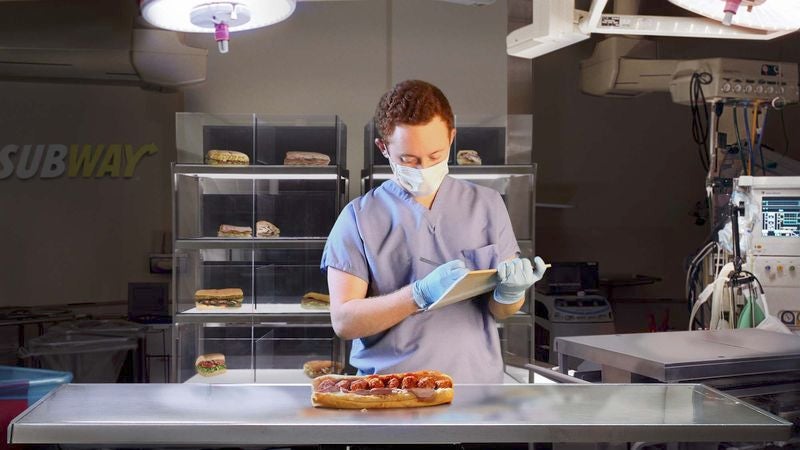MILFORD, CT—Announcing the creation of a genetically viable new menu item they said could soon appear in franchises nationwide, researchers with Subway’s sandwich breeding program revealed Thursday they had successfully developed a Black Forest Ham–Meatball Marinara hybrid.
The footlong sub, which company officials say was selectively bred to incorporate the zesty traits of the Meatball Marinara bloodline with the natural smokiness of the Black Forest Ham genus, was unveiled at a press conference at Subway’s main sandwich breeding and husbandry facility within its corporate headquarters.
“It’s taken over six years of genomic research and countless breeding attempts, but I’m happy to report that we’ve produced a robust new offspring from two of our most delicious subs,” said Noah Plattner, director of Subway’s sandwich breeding division, adding that the hybrid was morphologically compatible with any of the chain’s nine bread options. “This was a group effort that required the skills of our professional handlers, technicians, and fertility experts, all of whom worked without rest to produce this perfectly bred combination of succulent ham, fresh vegetables, and tangy marinara sauce.”
“Everyone involved in the creation of S-74G—or the Black Forest Marinara Combo, as it has been dubbed by our team of geneticists—should be extremely proud,” he added.
According to Plattner, the hybrid sandwich began as an attempt to improve the stock of the popular but increasingly inbred Meatball Marinara pedigree by crossbreeding it with a suitable mate. Scientists at the company’s state-of-the-art $200 million breeding laboratory identified the Black Forest Ham as a possible sire due to its heartiness, adaptability, and hereditary cheese layers.
After observing improvements in longevity and succulence over the first several generations of offspring, the research team reportedly decided to ramp up the number of mating sessions per week in the hopes of breeding out a latent sogginess trait and increasing the progeny’s natural tolerance to a wider variety of sauces.
“The results were promising right from the outset—taste-wise, S-74G seemed to take the best attributes of both parents while exhibiting an innate savoriness all its own,” said Plattner, who oversaw the selection of each procreative pair. “Moreover, the hybrid’s physical traits—in particular, its juicy yet cohesive mouthfeel—were found to be highly appealing to customers in our Provo, UT test market, even more so than the subs in its ancestral lineage.”
Added Plattner, “This is a very promising new specimen that I can see being offered alongside our heritage breeds, like the Roast Beef, Cold Cut Combo, and Italian B.M.T., for a long time to come.”
Subway officials went on to note how smoothly the process of crossing the two disparate subgenera had gone, given that the varying windows of fertility for each sandwich breed often cause complications for mating. Company scientists also explained the vital role that the various strains’ temperaments play in the interbreeding process, citing an incident in 2009 when an entire brood of docile Veggie Delite sandwiches were lost after being left unsupervised around a group of much larger and more aggressive Steak & Cheese subs.
In another case illustrating the challenges of sandwich husbandry, Plattner described how researchers had spent months trying to coax the notoriously wary and apprehensive Subway Club and a Spicy Italian to breed naturally before finally resorting to artificial insemination.
“Unfortunately, it’s not uncommon for cross-breeding attempts to show promise at first, only to yield a litter of sickly, undersized offspring,” Plattner said. “But that’s just the nature of our work. Some sandwiches reproduce with no trouble whatsoever, while other times you can mate two fertile, seemingly compatible subs, such as the Turkey Breast and Chicken & Bacon Ranch Melt, and then find out that their progeny is utterly inedible. Frankly, most of the specimens we produce here are too malformed and grotesque to proceed forward with and have to be euthanized.”
“However, sometimes even our mistakes turn out to be happy accidents,” he continued. “The Sweet Onion Chicken Teriyaki was only created through a mishap in our gene-splicing lab, and never in a million years did we think anyone would want to actually eat it.”







